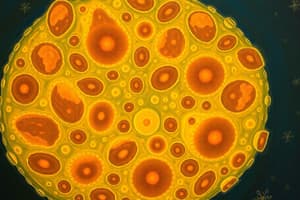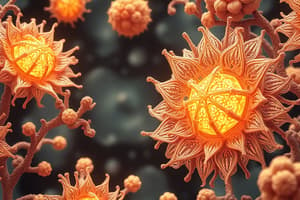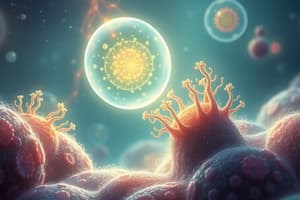Podcast
Questions and Answers
Which characteristic distinguishes protists from prokaryotic cells?
Which characteristic distinguishes protists from prokaryotic cells?
- Unicellularity
- Presence of a cell wall
- Reproduction through binary fission
- Presence of organelles (correct)
How have advances in eukaryotic systematics affected the classification of protists?
How have advances in eukaryotic systematics affected the classification of protists?
- Maintained the traditional classification systems
- Simplified the classification of protists
- Confirmed the validity of Kingdom Protista
- Led to the abandonment of Kingdom Protista (correct)
What nutritional strategies are observed in protists?
What nutritional strategies are observed in protists?
- Only heterotrophy
- Only autotrophy
- Autotrophy, heterotrophy, and mixotrophy (correct)
- Only osmotrophy
What is the significance of endosymbiosis in the evolution of protists?
What is the significance of endosymbiosis in the evolution of protists?
According to the theory of endosymbiosis, which event led to the evolution of plastids?
According to the theory of endosymbiosis, which event led to the evolution of plastids?
Which of the following describes secondary endosymbiosis?
Which of the following describes secondary endosymbiosis?
What adaptation is characteristic of excavates?
What adaptation is characteristic of excavates?
How do parabasalids generate energy, given their reduced mitochondria?
How do parabasalids generate energy, given their reduced mitochondria?
Which of these features is characteristic of Euglenozoa?
Which of these features is characteristic of Euglenozoa?
What is a kinetoplast?
What is a kinetoplast?
Which characteristic defines the 'SAR' clade?
Which characteristic defines the 'SAR' clade?
What unique trait do stramenopiles possess?
What unique trait do stramenopiles possess?
How do diatoms contribute to carbon cycling?
How do diatoms contribute to carbon cycling?
What is the primary structural component of oomycete cell walls?
What is the primary structural component of oomycete cell walls?
Which of the subsequent features is exclusive to alveolates?
Which of the subsequent features is exclusive to alveolates?
What ecological phenomenon is caused by dinoflagellates?
What ecological phenomenon is caused by dinoflagellates?
How do apicomplexans disseminate throughout their host?
How do apicomplexans disseminate throughout their host?
How do ciliates maintain osmotic balance in freshwater environments?
How do ciliates maintain osmotic balance in freshwater environments?
How do radiolarians capture microorganisms?
How do radiolarians capture microorganisms?
Which of the following supergroups includes land plants?
Which of the following supergroups includes land plants?
What photosynthetic pigment is characteristic of red algae?
What photosynthetic pigment is characteristic of red algae?
Which group of green algae is most closely related to land plants?
Which group of green algae is most closely related to land plants?
Which evolutionary trend is seen in the green algae leading to greater complexity?
Which evolutionary trend is seen in the green algae leading to greater complexity?
Which characteristic defines the Unikonta supergroup?
Which characteristic defines the Unikonta supergroup?
What type of pseudopodia is characteristic of amoebozoans?
What type of pseudopodia is characteristic of amoebozoans?
How do photosynthetic protists contribute to aquatic ecosystems?
How do photosynthetic protists contribute to aquatic ecosystems?
What is the impact of increased sea surface temperature on phytoplankton communities?
What is the impact of increased sea surface temperature on phytoplankton communities?
Which process is crucial for delivering nutrients to phytoplankton communities?
Which process is crucial for delivering nutrients to phytoplankton communities?
In the context of protist evolution, what significant event is associated with the Archaeplastida supergroup?
In the context of protist evolution, what significant event is associated with the Archaeplastida supergroup?
What distinguishes Stramenopiles from other protist groups in terms of flagellar structure?
What distinguishes Stramenopiles from other protist groups in terms of flagellar structure?
What criteria primarily define the classification of protists within the 'SAR' clade?
What criteria primarily define the classification of protists within the 'SAR' clade?
Which factor has most significantly challenged the traditional Kingdom Protista classification?
Which factor has most significantly challenged the traditional Kingdom Protista classification?
What evolutionary advantage did the endosymbiosis of cyanobacteria provide to early eukaryotes?
What evolutionary advantage did the endosymbiosis of cyanobacteria provide to early eukaryotes?
What is the role of contractile vacuoles in ciliate osmoregulation?
What is the role of contractile vacuoles in ciliate osmoregulation?
How do mixotrophic protists, like Euglena, adapt to varying environmental conditions?
How do mixotrophic protists, like Euglena, adapt to varying environmental conditions?
What ecological service do protists in coral reefs provide?
What ecological service do protists in coral reefs provide?
Flashcards
What is a protist?
What is a protist?
Mostly unicellular eukaryotes that are not plants, animals, or fungi
Diversity of Protists
Diversity of Protists
Protists exhibit more structural & functional diversity than any other group of EUKARYOTES.
What is endosymbiosis?
What is endosymbiosis?
A relationship between two species in which one organism lives inside the cell or cells of the other organism (the host)
Mitochondria & plastids
Mitochondria & plastids
Signup and view all the flashcards
What are Excavates?
What are Excavates?
Signup and view all the flashcards
Diplomonads & Parabasalids
Diplomonads & Parabasalids
Signup and view all the flashcards
What are Euglenozoa?
What are Euglenozoa?
Signup and view all the flashcards
What are Kinetoplastids?
What are Kinetoplastids?
Signup and view all the flashcards
Apicomplexans
Apicomplexans
Signup and view all the flashcards
What are sporozoites
What are sporozoites
Signup and view all the flashcards
What is the SAR clade?
What is the SAR clade?
Signup and view all the flashcards
What are Stramenopiles?
What are Stramenopiles?
Signup and view all the flashcards
What are Diatoms?
What are Diatoms?
Signup and view all the flashcards
What are Brown Algae
What are Brown Algae
Signup and view all the flashcards
What are Oomycetes?
What are Oomycetes?
Signup and view all the flashcards
The SAR clade.
The SAR clade.
Signup and view all the flashcards
What are Alveolates?
What are Alveolates?
Signup and view all the flashcards
What are Dinoflagellates?
What are Dinoflagellates?
Signup and view all the flashcards
What are Ciliates?
What are Ciliates?
Signup and view all the flashcards
What are Radiolarians?
What are Radiolarians?
Signup and view all the flashcards
What is Archaeplastida?
What is Archaeplastida?
Signup and view all the flashcards
What is Red Algae?
What is Red Algae?
Signup and view all the flashcards
What is Green Algae?
What is Green Algae?
Signup and view all the flashcards
What is Unikonta?
What is Unikonta?
Signup and view all the flashcards
What are Amoebozoans?
What are Amoebozoans?
Signup and view all the flashcards
Protists in aquatic ecosystems
Protists in aquatic ecosystems
Signup and view all the flashcards
Role in ecosystems
Role in ecosystems
Signup and view all the flashcards
Apicomplexans
Apicomplexans
Signup and view all the flashcards
Brown Algae
Brown Algae
Signup and view all the flashcards
Unikonta
Unikonta
Signup and view all the flashcards
Study Notes
- Protists are mostly unicellular eukaryotes, that are neither plants, animals, nor fungi.
- Protists are eukaryotes with organelles and are more complex than prokaryotic cells.
- Advances in eukaryotic systematics have changed the classification of protists, making Kingdom Protista no longer valid.
Eukaryotic Supergroups
- There are four supergroups of Eukaryota: Unikonta, Excavata, SAR, and Archaeplastida.
Structural and Functional Diversity
- Most protists are unicellular, though some are colonial or multicellular.
- Protists are nutritionally diverse, including photoautotrophs, heterotrophs, and mixotrophs.
- Photoautotrophs contain chloroplasts.
- Heterotrophs absorb organic molecules or ingest larger food particles.
- Mixotrophs combine photosynthesis and heterotrophic nutrition; Euglena is an example.
- Some protists reproduce asexually via fission
- Some reproduce sexually via processes of conjugation, fertilization, and meiosis
Protistan Diversity
- Protistan diversity can be traced to endosymbiosis.
- Endosymbiosis is when one organism lives inside another.
- Mitochondria and plastids are derived from prokaryotes engulfed by early eukaryotic cells.
- Mitochondria descended from an alpha proteobacterium engulfed by an archaeal lineage.
- Over time, the endosymbiont bacterium could no longer lead an independent life because the genes originally present on its chromosomes moved to the host's nuclear genome via horizontal gene transfer.
- Plastids evolved later from a photosynthetic cyanobacterium engulfed by a host heterotrophic eukaryote.
- Plastid-bearing protists evolved into photosynthetic protists, for example, red and green algae.
Primary and Secondary Endosymbiosis
- Plastids evolved initially from cyanobacteria engulfed by an ancestral heterotrophic eukaryote (primary endosymbiosis).
- Descendants diversified into red algae and green algae
- Some red and green algae were then engulfed by other eukaryotes (secondary endosymbiosis).
- A heterotrophic eukaryote engulfs a cyanobacterium, leading to primary endosymbiosis resulting in three membranes
- The cyanobacterium inside the eukaryote has three membranes, one of which will be lost in red and green algal descendants.
- Secondary endosymbiosis led to:
- Stramenopiles and alveolates with plastid and nucleus
- Euglenids with plastid, nucleus, and flagella
- Chlorarachniophytes with plastid, nucleus, and pseudopodia
Supergroup Excavata
- Are protists with modified mitochondria, unique flagella and cytoskeleton.
- Diplomonads and parabasalids live in anaerobic environments and are parasitic
- Diplomonads have two equal-sized nuclei and multiple flagella, for example, Giardia intestinalis.
- Giardia intestinalis are found in mammalian intestines, and can cause parasitic infection if consumed in drinking water.
- Parabasalids have reduced mitochondria called hydrogenosomes that generate energy anaerobically
- Trichomonas vaginalis is a parabasalid and the pathogen that causes yeast infections in human females.
- Trichomonas vaginalis was not a pathogen originally, but acquired a pathogenic gene via transformation from vaginal bacteria.
- Euglenozoa are a diverse clade including predatory heterotrophs, autotrophs, parasites, & mixotrophs.
- Euglenozoa main feature is a spiral or crystalline rod inside their flagella
- Euglenids have one or two flagella that emerge from a pocket at one end of the cell
- Euglena are found in pond water, with some species being autotrophic and heterotrophic
- Kinetoplastids have a single mitochondrion with an organized mass of DNA called a kinetoplast.
- Free-living species are consumers of prokaryotes in freshwater, marine, and moist terrestrial ecosystems.
- Some species are parasitic
- Trypanosoma causes African sleeping sickness in humans.
- Another Trypanosoma species causes Chagas' disease.
- Some Trypanosomes evade immune detection by switching surface proteins from generation to generation, preventing the host from developing immunity.
Supergroup SAR
- "SAR" is a diverse monophyletic supergroup named for the first letters of 3 major clades:
- Stramenopiles
- Alveolates
- Rhizarians
Stramenopiles
- Contain some of the most important photosynthetic organisms on Earth
- Most have a "hairy" flagellum paired with a "smooth” flagellum
- Stramenopiles include diatoms, brown algae, and oomycetes
Diatoms
- Are unicellular algae with a unique two-part, glass-like wall of silicon dioxide
- Their wall is divided into two overlapping parts
- Parts enable live diatoms to withstand immense pressure, preventing crushing jaws of predators.
- Are a major component of phytoplankton and are highly diverse.
- Dead diatom walls compose sediments known as diatomaceous earth
- After a diatom population has bloomed, individuals fall to the ocean floor where they're not broken down by decomposers.
- This removes carbon dioxide from the atmosphere and "pumps” it to the ocean floor.
- Through carbon fixation, diatoms remove carbon dioxide from the atmosphere
- The carbon dioxide is converted to organic carbon and oxygen is released as a product
Brown Algae
- Largest and most complex protists
- Are multicellular; most are marine
- Include many species commonly called "seaweeds"
- Kelps live in deep parts of the ocean.
- Algal seaweeds have plantlike bodies with rootlike holdfasts that anchor them to the ocean floor and stemlike stipes which support their blades.
- Similarities between algae and plants are examples of analogous structures.
- Algin in their cell walls is used to thicken processed food.
Oomycetes
- Are Stramenopiles that include water molds, white rusts, and downy mildews.
- Were misidentified as fungi due to their multinucleate filaments that resemble fungal hyphae.
- Oomycetes cell walls are composed of cellulose, rather than chitin, unlike fungi.
- Based on molecular analysis, oomycetes and fungi are not closely related.
- Oomycetes are related to plastid-bearing groups, but do not have plastids or perform photosynthesis.
- Nutrients are acquired through parasitism or decomposition.
- Phytophthora infestans is a parasite that causes potato late blight, and kills potato crops.
Alveolates
- Members of the clade Alveolata have membrane-enclosed sacs (alveoli) just under the plasma membrane
- This clade includes:. Dinoflagellates, Apicomplexans, and Ciliates
Dinoflagellates
- Have two flagella; each cell has cellulose plates
- Are an abundant unicellular algae, components of both marine & freshwater plankton
- Dinoflagellates in symbiosis nourish coral polyps building reefs.
- Are a diverse group of aquatic phototrophs, mixotrophs & heterotrophs
- Toxic "red tides" are caused by dinoflagellate blooms.
- Dramatic reproduction of Karenia brevis in the Gulf can produce brevetoxins
- Brevetoxins can kill fish, crabs, turtles, etc.
Apicomplexans
- One end, the apex (tip), contains a complex of organelles specialized for penetrating host cells and tissues.
- They spread through their host as infectious cells called sporozoites.
- Plasmodium causes malaria.
- Plasmodium embeds itself in human red blood cells.
- Requires two or more different host species for completion of life cycle
- Anopheles mosquitos and humans can both host it
Ciliates
- Contain motile cilia for locomotion and feeding
- Cilia means "eyelash” in Latin
- Cilia are organelles and slender protuberances.
- Contain two nuclei called macro and micro nuclei.
- Contractile vacuoles are present and live in fresh water
- They pump water out if placed in hypotonic solutions
- Example of ciliates is the paramecium
Reproductive Processes
- Conjugation = Sexual Reproduction
- Transverse Fission = Asexual Reproduction
Rhizarians
- Many species in the rhizarian clade are amoebas
- Amoebas are in the SAR Clade, and the eukaryote supergroup Unikonta
- Marine protists called radiolarians have delicate, symmetrical internal skeletons made of silica.
- Radiolarians' thread-like pseudopodia engulf microorganisms by phagocytosis.
- Amoebas move and feed by extensions of the cell cytoplasm called pseudopodia.
Supergroup Archaeplastida
- Includes red & green algae and land plants.
- Land plants are descended from ancient protists that were green algae.
- Endosymbiosis of cyanobacterium to unicellular green algae to land plants was the evolution of chloroplasts.
Red Algae
- 6,000 species are "rhodophytes," which contain phycoerythrin, a red photosynthetic pigment.
- Species that are adapted to shallow water have less phycoerythrin and appear green.
- The red pigment masks the green chlorophyll if a significant amount is present.
- Most are multicellular and used in agar gel, carrageenan, and Sushi wraps.
Green Algae
- Descended from plants
- These are named for their green chloroplasts
- These are divided into Chlorophytes and Charophytes
- Chlorophytes have many different specimens
- Charophytes are closely related to land plants and ancestors
Green Algae Complexity
- Large size and greater complexity evolved in green algae by 3 different mechanisms:
- Formation of colonies from individual cells, for example, Volvox
- Formation of true multicellular bodies by cell division and differentiation, for example, Ulva
- Repeated division of nuclei with no cytoplasmic division (Caulerpa)
Supergroup Unikonta
- Includes protists closely related to fungi & animals
- The root of the eukaryotic tree remains controversial
- It is unclear whether unikonts separated from other eukaryotes relatively early or late
- Unikontas are fungi, animals & protists (choanoflagellates & amoebozoans)
- Chaonoflagellates are related to animals than other protists
Amoebozoans
- Are amoebas that have lobe- or tube-shaped pseudopodia
- Include slime molds, entamoebas & gymnamoebas.
- Dictyostelium discoideum is a slime mold used as a model organism for the study of multicellular evolution.
Entamoebas
- Are parasites of vertebrates and some invertebrates
- Some are free-living species. -Entamoeba histolytica causes amebic dysentery (infectious diarrhea) and is the 3rd leading cause of human death due to eukaryotic parasites.
Ecological Communities
- Protists are found in diverse aquatic and moist terrestrial environments
- Photosynthetic dinoflagellates form symbiotic relationships in coral reefs, which provide nourishment to hosts (coral polyps) building coral reefs.
- Dinoflagellates and diatoms constitute plankton
- Protists obtain energy from the sun that are important producers
- Photosynthetic protists and prokaryotes are the main producers in aquatic environments
- Biomass has declined because of sea surface temperatures increasing Growth of phytoplankton communities relies on nutrients delivered to the ocean bottom through upwelling
- warm surface water acts as barrier that prevents it
- marine ecosystems and fishery yields may face large effects from global warming due to the interference with the process of upwelling
- Current efforts explore the possibility of using algae to produce biodiesel fuel
Studying That Suits You
Use AI to generate personalized quizzes and flashcards to suit your learning preferences.




